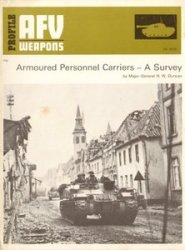A considerate commander, General Horrocks made it a practice to issue orders as early as possible each evening so as to permit those required to fight next day the maximum amount of rest. He had an articulate and practical staff. The orders given to the corps for 18th September ensured that additional infantry would be available to support the Guards in the close country ahead and endorsed the need to press the advance towards Arnhem. When the weather report was read, the chief gunner recognised that he must be ready to provide for all the supporting fire next day; it was said that the evening rain clouds would persist and restrict, probably prevent air operations for the next twenty-four hours.
At 0600 hours on Monday morning, the Welsh Guards group began their encounter with Kampfgruppe Walther. Once more, the 2nd Household Cavalry reconnoitred and probed the countryside ahead. By 1230 hours, two of their armoured cars had sneaked into Eindhoven while the main force was battling through the woods south of Aalst. In Eindhoven, they found Colonel Sink
And the 506th Parachute Infantry, heroes of the city, struggling to free themselves from the welcoming burghers in order to capture what remained of the German garrison.
Colonel Sink’s regiment had passed over the Wilhelmina canal at Zon by midnight using the footbridge prepared by their parachute engineers. With very limited resources, this had been strengthened to accept a few light vehicles but it was incapable of bearing trucks, still less tanks. General Taylor was therefore more than ever determined to capture the bridge at Best. Early in the morning. Colonel Michaelis sent a second battalion of the 502nd to join the fighting on the edge of the Zonsche forest. Equally, the majority of General Poppe’s 59th Division were concentrating to force the Americans back. Being infinitely stronger and backed by artillery, they came close to overpowering the advancing battalions until a brief period of finer weather permitted an air strike by a
German troops move in toward the British dropping zone
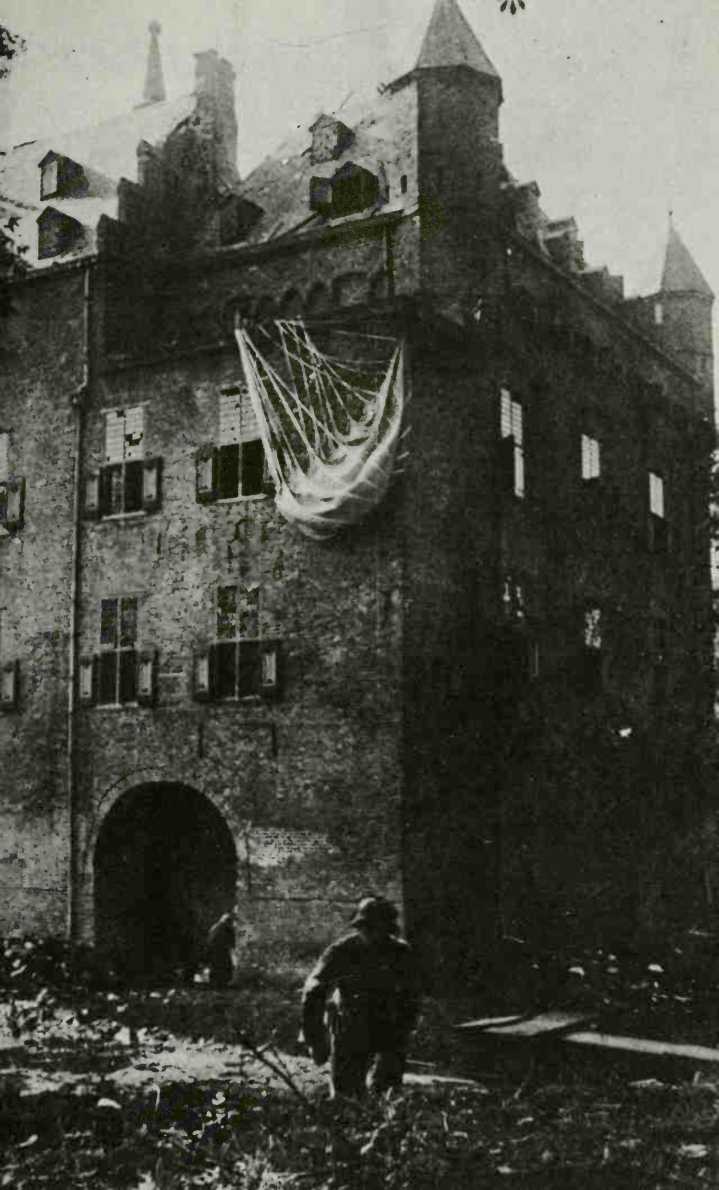
Flight of P-47S. The two battalions drew back to combine their defences. In the fighting, one of the commanding officers was killed.
Close to the steel and concrete road bridge lay the patrol sent out during the previous afternoon from the 502nd. Its commander was Lieutenant Wier-zbowski. He had been despatched with over eighty infantry and engineers but on the night march, during several encounters with the enemy, mistakes, panic and casualties had reduced the party. He now mustered fifteen beside himself. After dawn on the 18th, they heard firing and over a period of hours the rattle and bang grew closer. What they could hear was the approach of first one and then the other battalion from their regiment - but so could the German engineers on the bridge. At 1100 hours, fearing capture, they shattered the concrete and steel in a single loud explosion. Then the battle noises faded again. From the bridge, a German platoon came to attack Wierzbowski’s patrol, killing one and wounding four of the survivors. They were driven off. In the afternoon, the two armoured cars of the British Household Cavalry which had reached Eindhoven came into view on the far side of the canal and for a time their machine guns helped to rebuff the persistent German attempts to destroy this determined little post. Between actions, for the remainder of the afternoon, both British and American radios on the canal tried to discover what was happening in the lOlst’s area.
If they had been successful, they would have discovered that it was an afternoon of inactivity. The battalions in the Zonsche forest were baulked of their wish to capture the Best bridge but denied equally the attempts of the 59th Division to overwhelm them. The third battalion of the regiment. Lieutenant - Colonel Patrick Cassidy’s at Odenroode, made good use of his time to improve the defences. There was every sign that they were shortly to be assailed. At Veghel, the 501st were subject to the same reconnaissance and probing. General Taylor was relieved to see two glider battalions arrive that afternoon, delayed by the weather, with more vehicles and radios, supplies and a pair of bulldozers. He greatly regretted however, the absence of his artillery.
To the north, the immediate problem occupying General Gavin was the capture of the Nijmegen bridge. After their night encounter in the centre of Nijmegen, the 10th SS battle group had counterattacked the company of the 508th until, ending a confused struggle in the darkness, both sides had drawn apart. To the relief of Colonel Warren, his B Company, drawn by the sound of firing, suddenly reported and he at once asked his regimental commander to release C Company in order that he might attack the bridge in strength. While the conversation took place over the radio, a Dutch civilian approached Captain Jonathan Adams, commanding A Company, to say that the mechanism for the demolition of the road bridge was housed in the post office, a few blocks to the north. He offered to guide him there. With his battalion commander’s permission. Captain Adams took a patrol away with the Dutchman who skilfully guided them through numerous side streets to the edge of their destination. After receiving a simple plan of action whispered in the darkness, the paratroops stormed the building and overwhelmed the German guards. The demolition mechanism was quickly destroyed. But when they came to leave the building it was surrounded by German troops. Captain Adams had to revise quickly his ideas and block the entrances. He was evidently faced with a siege.
Meanwhile, Colonel Warren had made some headway with his attack on the bridge, advancing close to the southern end. Whatever his hopes, the fire from the immediate area of the crossing, a weak German attack on his own position and the light of dawn kept him from capturing it. Captain Adams and his patrol had not returned, and C Company was still in regimental reserve. A renewed attack must therefore depend upon B Company and a part of A. Shortly, General Gavin arrived to find the battalion headquarters at work in the Marien-boom School.
It did not take the shrewd Gavin long to see that, scattered and tired
After eighteen hours continuous activity, Warren’s force needed to he concentrated and given a rest. Ordering them to draw back, the divisional pommander was at the same time concerned to try again to capture the [bridge which, so close now, was still far from being in his possession.
There was little to spare from the essential defences; the 504th were holding the Maas crossing at Grave and the Maas-Waal canal; the 505th was defending the greater part of the Wights and the southern glider zone but could not also embrace the northern sector of the ridge; thus the 508th had to commit part of its strength north of Groesbeek, part in Nijmegen. [The northern glider sector would also ;heed to be cleared by midday for the follow-up landings.
In such circumstances. General Gavin decided to send a single company to try to capture the bridge supported by the fire of his parachute ,artillery and all the mortars within range. He believed that, approaching 'from a new direction - the south - a .small determined body might still •carry off the task with surprise. It may also be that he was half-inclined to believe that the Germans were withdrawing from the city. During the night, a railway train had passed [through the centre of the divisional area without check, though all the passengers aboard were enemy soldiers. Until it passed, no one thought to stop it. Observing this success, a German commander had filled a second train at Nijmegen station. But aroused and ready, the 82nd had contrived an efficient block across the tracks down the line, round which an ambush waited. The prisoners taken were fearful and irresolute, mostly from garrison and other staffs. They claimed that orders had been given to evacuate the city.
So G Company of the 508th Regiment marched down from its position on top of Hill 64 towards the Waal and the bridge. At 0745 hours that morning they passed a radio message to say that they were moving to an assault location. The Dutch crowds, wearing their orange favours, fell back and they were alone.
Approach through Oosterbeek

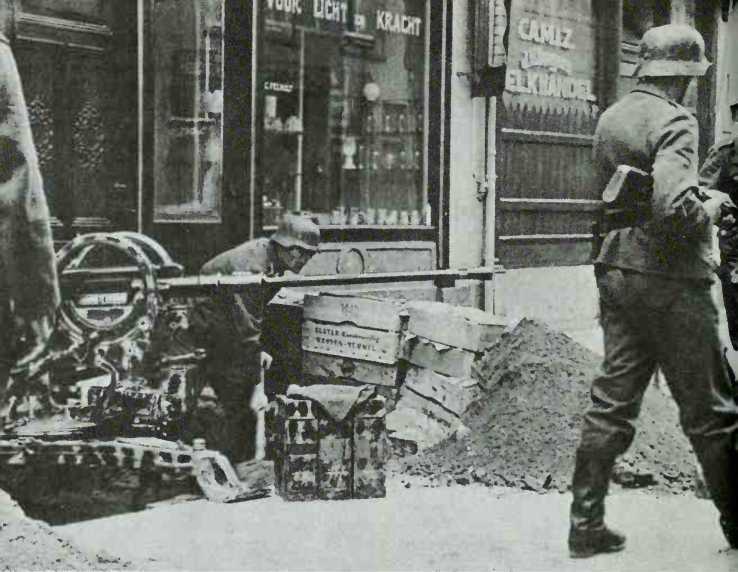
Above: 20mm flak gun is set up on the German barrier defence in Arnhem. Below: German troops in positions outside the city
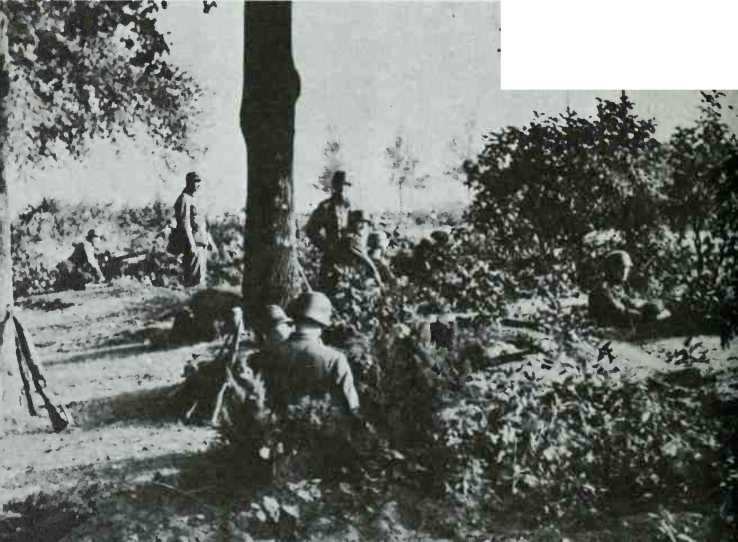
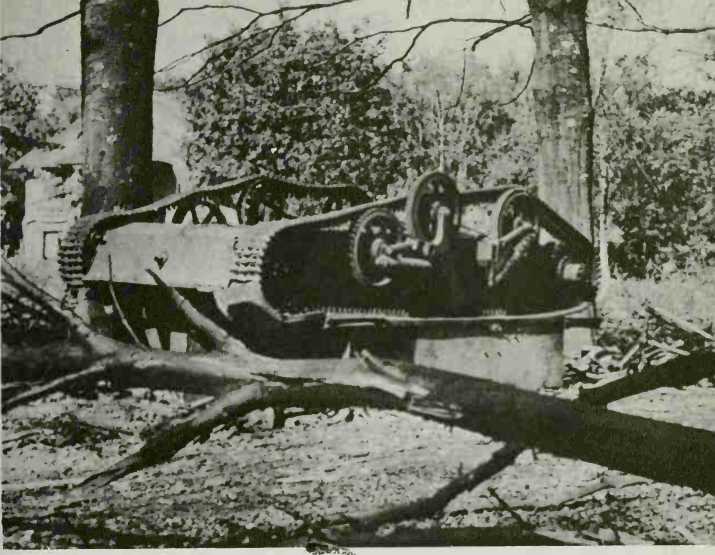
Above: British carrier knocked out on 17th September. Below: Harzer's panzers move in
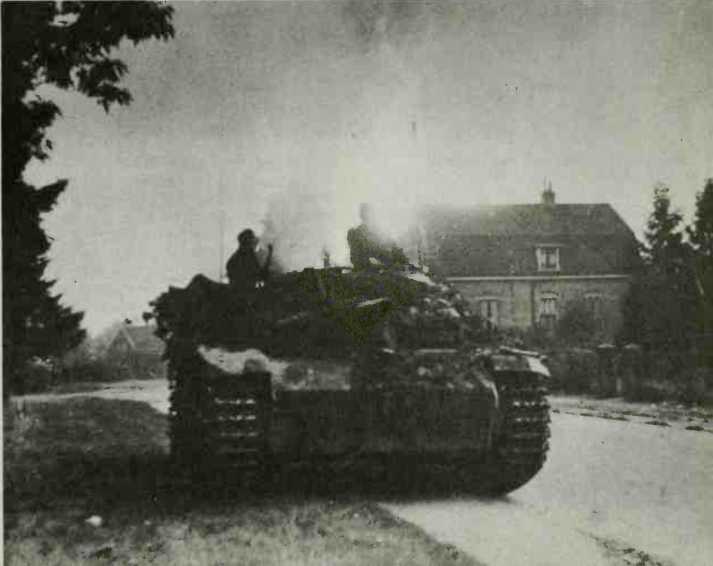
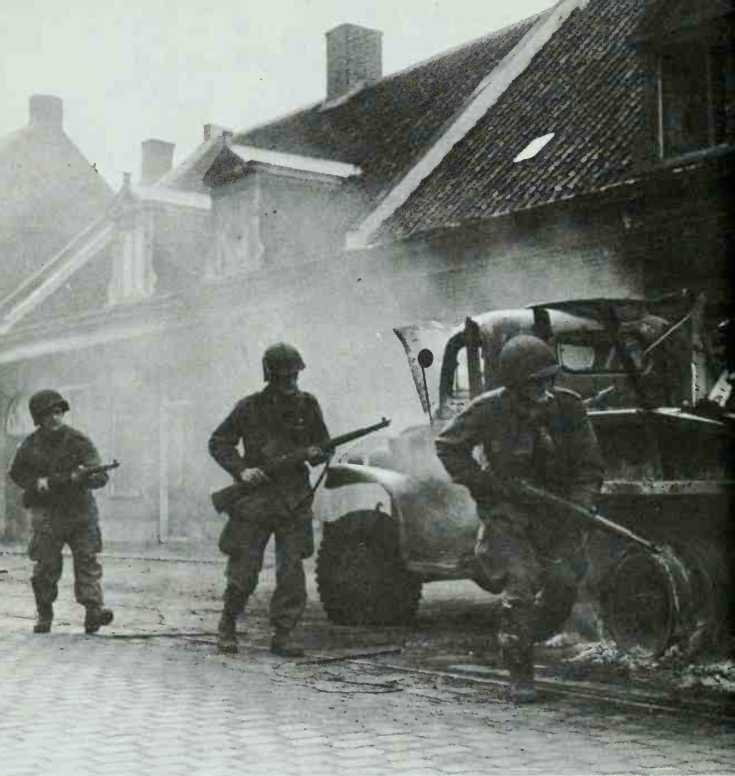
US paratroops street fighting in Holland
What General Gavin did not know was that the reconnaissance battalion of the 9th, in addition to the group of the 10th SS Panzer Division, had now reached the Nijmegen area where they had taken local flak units under their control. The 20mm and 88mm guns of the latter were the first to fire on G Company, followed soon by machine guns, rifles and carbines as Captain Novak, their commander, led them in a dash along the sides of the street. Other German posts on the far side of the river opened fire. Rightly, the company was halted. They took up their own fire positions in the buildings at hand.
As the morning wore on, Germans were seen to be infiltrating westward from the Reichswald forest. An attack developed against the company defending the southern landing zone for the gliders. Continuous skirmishing vexed the paratroops until at last, with some artillery support, they made a sortie to clear the many groups infesting the area. They were found to be from the 406th (Landes-schutzen) Division of Korps Feldt. On the northern zone, about 500 Germans were in occupation with sixteen 20mm anti-aircraft guns which closed towards Beek. Novak’s company was still in Nijmegen; there was no resistance to hand. Called from their rest at 1000 hours, Warren’s battalion made a forced march from Nijmegen to
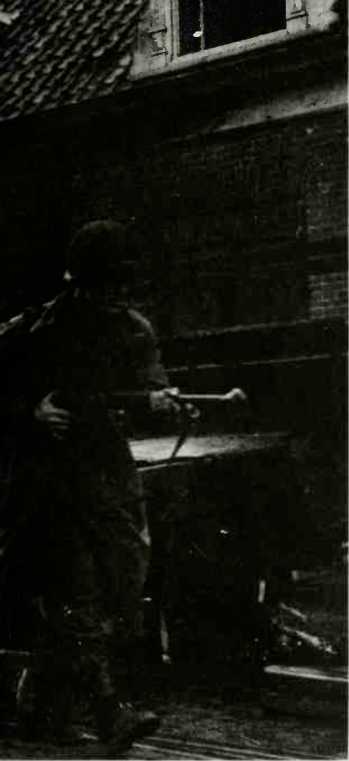
Rendezvous with their C Company shortly after midday. The gliders were due at 1300 hours. With so little time in hand, Lieutenant-Colonel Shields Warren Jr, spread his battalion out quickly and gave the simple order to charge. They emerged from cover and began to run downhill towards the Germans and their guns. The enemy infantry wavered, then ran, some into the fire of their own flak weapons which drove off to new positions out of sight. Warren’s companies reached the far side of the landing zone just as the aircraft and gliders appeared. They had taken 150 prisoners and were to find another fifty bodies when they returned across the zone later. Now they stood back as the gliders flew in to a safe landing.
Gavin was more comfortable with the arrival of his remaining artillery, though he needed urgently the glider infantry. He felt instinctively that the Reichswald forest would soon disgorge something more menacing than detachments from Korps Feldt and he had still to capture Nijmegen bridge. He had learned, too, in the latter part of the morning that Arnhem was occupied by strong forces. His liaison officer with the Dutch resistance movement. Captain Brestebeurje, had been shown details of the private telephone system of the Gelderland Electricity Company, still fully operating. It was used to pass quick simple news items and one had come from the power station at Arnhem. It said: ‘Germans beating back British.’
As Sunday evening passed, General Willi Bittrich grew restless. In the afternoon he had told Model what additional units he would need to destroy the British north of the Rhine; a bill of reinforcement set out in detailed terms as both men now knew from Student how much of the British airborne division had arrived and what they were planning to do. Later, he had heard from Harzer that his reconnaissance battalion was on its way to Nijmegen while the remainder of 9th SS Panzer Division, as Karnpf-gruppe Harzer, drew into Oosterbeek and Arnhem. One battle group of 10th SS Panzer had also departed for Nijmegen but after further thought he had kept back the majority in their divisional area, ready to move either into Arnhem or to reinforce Nijmegen.
Reports grew vaguer and fewer: nothing had been seen in Arnhem and there were no signs of the Americans in Nijmegen. Bittrich decided to go into Arnhem to see how matters stood in the city and he drove to the garrison headquarters. All but a small watch were manning defences and General Kussin was said to be visiting the SS Training Battalion. It was expected that when he returned he would be able to offer an intelligence picture of British movements. Discovering two German servicewomen operating the telephone switchboard, Bittrich asked them to repeat every piece of information they received to his headquarters - a promise they kept, earning themselves an Iron

Brigadier Lathbury commanded the British 1st Parachute Brigade
Cross apiece. He decided not to wait for Kussin but drove back to Doetin-chem.
After an hour at his headquarters, there was still no news. In darkness, he drove back towards Arnhena, finding Harzer’s command post among the woods by Staadsbosch, One battle group, he was told, had been sent along the railway towards Wolfheze under the artillery commander, Lieutenant-Colonel Spindler. Another was moving south towards the Rhine between Arnhem and Oosterbeek; a third to Arnhem road bridge, which various sources reported as captured by the British on the north side. Harzer’s operations were not made easier by the fact that there were a number of small units or detachments fighting in the area who were not under his command. Hence they passed their information back to other headquarters and much of what he had received from them had been on a chance basis.
Bittrich decided that nothing of what he had heard or seen necessitated a change of plan. He needed only to refine his arrangements. All the remaining units of 10th SS Panzer were to leave at once for Nijmegen, taking the ferry at Pannerden to avoid delay in fighting the British at Arnhem bridge. Harzer would get his rbcon-naissance battalion back from Nijmegen but should meantime use the reconnaissance unit of the 10th. He was at once to assume command of all units in Arnhem and Oosterbeek. Operations by 9th SS Panzer were to accomplish three tasks:
‘1. To break the resistance of the British forces at the Arnhem bridge and to recapture the north end of the bridge.
2. To prevent the movement of reinforcements to the British forces at the bridge from the landing zones at Oosterbeek.
3. To reduce the enemy sector as soon as the additional troops and armour (which has been requested from Army Group B) arrive in the area and, having reduced the sector, to destroy the troops inside it.’ Spindler’s battle group had already
Struck the 1st Battalion near the railway. Obliged to move without one company which failed to find the rendezvous, Dobie’s column made a
Painful - journey across country through the rain and darkness. He noted in his diary:
‘0300 (Monday). Very had going through woods with guns, carriers etc. Bumped enemy post X tracks 697797 approx - caused enemy casualties - enemy withdrew. Major Bune and mortar detachment missing.
0430. Reached road junction 709783 - S Company ran into enemy fire - Enemy armoured cars off road - MG fire, 20 mm. and mortars. Attacked with S Company left flank - gained northern enemy position and inflicted casualties.
0700. Passed HQ Company 3rd Bn - took them along. . . ’
The 3rd Battalion had by morning been cut in two by Harzer’s battle group working south towards the Rhine bank. Quite apart from the weakness of the two halves. Brigadier Lathbury’s jeep and radio were now separated from him. While he was considering what his best course would be, a liaison officer from divisional headquarters appeared under the guidance of a member of the Dutch resistance. Urquhart and Lathbury were told that the second lift with the 4th Parachute Brigade and glider reinforcements were expected at 1500 hours. The two men decided to break away from Fitch’s column to return to their headquarters.
‘Would you care to throw a bomb, sir?’ asked the brigadier, offering his divisional commander a smoke grenade.
‘No, you’re much better at it than I am.’
The smoke burst in the open and Urquhart, Lathbury and his Intelligence Officer ran out into the street. Captain Cleminson of the 3rd Battalion, watching their departure, saw that they were making in the confusion of the moment directly towards the Saint Elizabeth Hospital which he knew to be occupied by Germans. He dashed after them but a machine gun fired quickly, nicking Lathbury’s spine. He was paralysed. The three officers lifted him into a house, 135 Alexander Straat, occupied by a middle-aged couple who offered their front room.
While they examined the brigadier and wondered what they should do
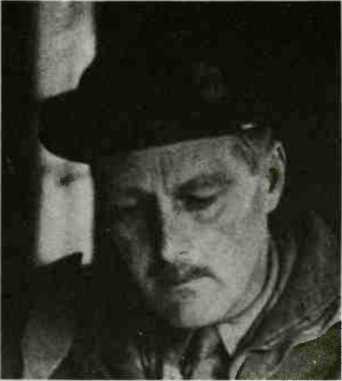
Brigadier 'Pip' Hicks.
Now that he was injured, a German soldier’s face appeared at the window. Urquhart quickly raised his automatic pistol and fired, killing him. A few moments later, the householders, who had withdrawn to converse together, came back to say that they would hide the wounded man and look after him. It was a generous act; they would both be shot if the Germans discovered what they were doing. Carrying Lathbury to a cupboard under the stairs, the three officers left by a side door and continued their journey.
At the bridge. Frost and his force remained in possession of the northern end. One company and the 2nd Battalion headquarters had reached it on the previous evening just as the Germans began to take up positions at the southern side. The railway bridge had been blown up in the faces of C Company as they seized it; B Company had attacked and screened the column from the knoll of Den Brink as they passed and A Company had completely killed or captured the remaining fifty enemy attempting to obstruct them, the field security police from II SS Panzer Korps. Later, brigade headquarters under the brigade major had arrived. Part of the brigade’s company of parachute engineers swelled the garrison and, after daylight on the Monday, inspected the bridge to find that it contained no
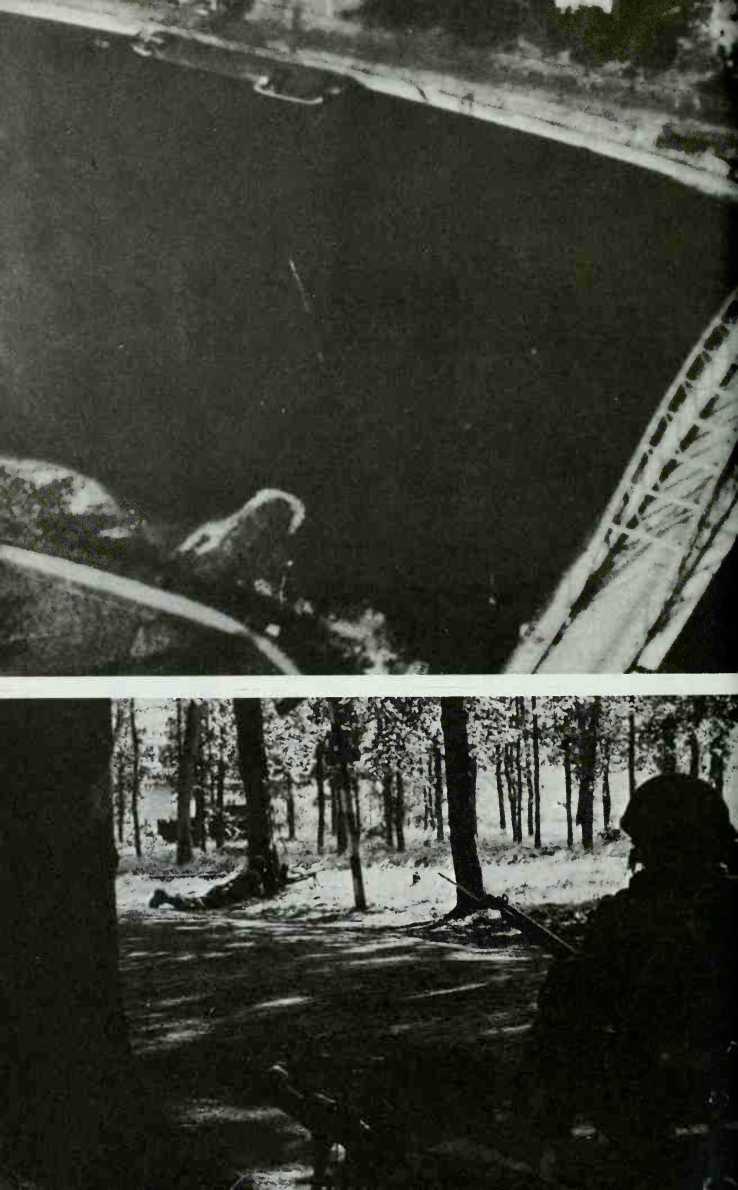
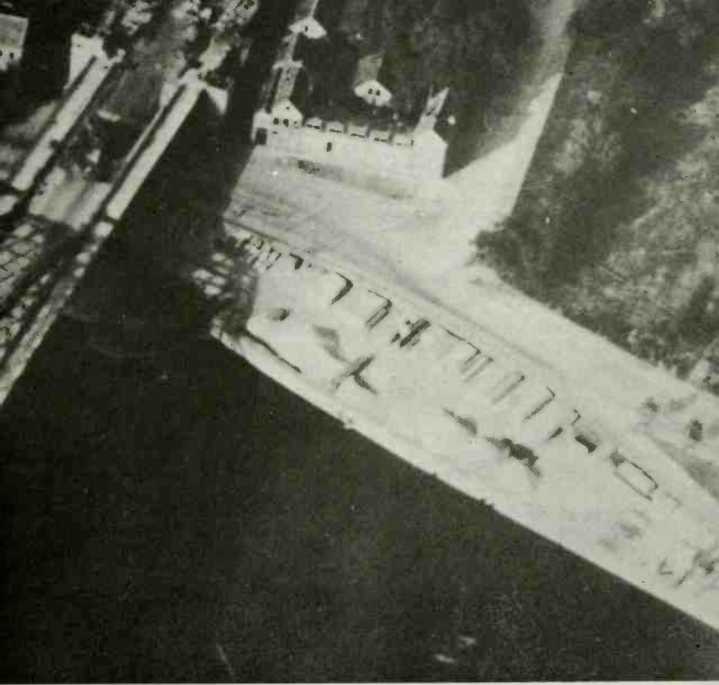
Above: Arnhem road bridge. Left: British paratroops in the woods near Wolfheze. The man in foreground is holding a Piat gun
Iemolition charges. This and other aews was relayed to divisional head-luarters through the artillery wireless net of the Forward Observation Dfficer. It was a comfort to know that the guns of one battery were close 3nough to support them.
Two gallant attempts were made to capture the southern end of the bridge but the enemy had mounted 20mm Qak guns to fire directly down the long open roadway. The Germans attacked from both ends at various times but failed to dislodge the parachutists. Returning from Nijmegen, Harzer’s reconnaissance battalion attempted to force their way across from the south and succeeded only in leaving ten of their vehicles blazing on the elevated paving under the grimly satisfied eyes of the defence.
Between these attacks, there were almost continuous battle noises from the town. Dobie had brought the 1st Battalion close to Den Brink and the Saint Elizabeth Hospital but the attacks they had made to reach this point had left him with only eighty-two unwounded men. The fit could no longer carry the casualties and the trail of their dead lay back through the streets held by Kampfgruppe Harzer. The 3rd Battalion were in an equal plight. The several commanders in the area were hoping increasingly that the arrival of the second lift from England would bring some relief.
At divisional headquarters. General Urquhart had still not returned: Brigadier Hicks of the Air-Landing Brigade had therefore assumed command. During the Sunday and the Monday morning, the battalion and half battalion which had arrived with
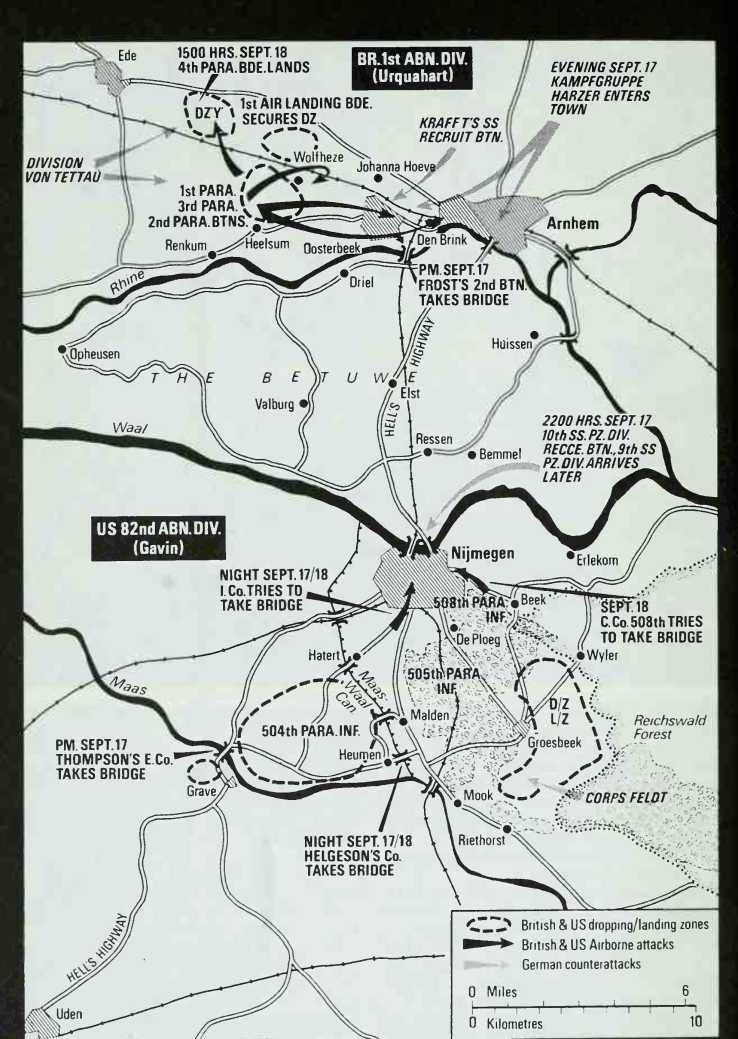
The situation in the US 82nd and British 6th Airborne Divisions' areas on 17th 18th September
Him by glider had been holding the dropping and landing zones to be used by the second lift. The attacks against them by Tettau’s units had not been worrying, though the zones were too expansive to be sealed completely against infiltration. The needs of Frost’s force, as reported by the artillery, were more serious. At 0945 hours, the half battalion of glider infantry were ordered to make their way to the road bridge and inform the brigade headquarters, incidentally, that all the radio frequencies had been changed in an attempt to improve communications. The glider battalion remaining, 7th King’s Own Scottish Borderers, stretched out their line of posts to repel infiltrators.
It had been planned to fly in the second lift during the morning but the weather did not permit it. It was 1500 hours before the aircraft appeared and the enemy had now full details of their direction of flight. Christiansen had moved a number of flak batteries into position while Tettau’s division made a special effort to attack with Colonel Lippert’s Herman Goring training units, a police battalion and the Dutch SS under Helle. Amongst them were other 20mm flak guns. The price of restricting air transport operations to a single sortie per day, with or without the loss of the operations plan to Student, had now to be paid at Arnhem as it was being paid by Gavin at Nijmegen and Taylor in the south. In one of the 4th Brigade’s aircraft ‘ . Suddenly
We saw a couple of planes behind us go down and somebody said, “There go some poor buggers” . . . Then we heard steel hitting the bottom of the plane but thank God nothing came through.’ Some distance away, Captain Frank King of the 10th Battalion noticed ‘many anti-aircraft guns and of course at 500 feet we were vulnerable even to MG and rifle fire... The American crew-chief was killed near the door. There was a certain disorder but no panic... I gave the order to jump . . . both plane engines were blazing.’
There was not only much more flak; the parachutists and glider units were landing on zones under aimed small arms fire and intermittent bursts from the flak guns, although the Scottish Borderers had successfully cleared or captured over 270 Germans from the immediate area. Brigadier Hackett, commander of 4th Brigade, did not of course know what had occurred to embarrass their reception but was vexed because in descending he had dropped his walking stick. Searching through the heather, he came on ten enemy soldiers to whom he called sharply in his excellent German, ‘Wait here! I’ll attend to you presently.’ Finding his stick, he then marched his captives to the rendezvous appointed for brigade headquarters.
Awaiting him, he found Lieutenant-Colonel CharlesMackenzie, Urquhart’s chief of staff, who told him all that had happened. Hackett did not like what he heard and resented the removal, without reference to him, of the 11th Battalion which was being sent directly to Arnhem bridge straight from the dropping zone without time to prepare for movement and independent of all other movements into the town. Senior to Hicks, he felt that the arrangements being made were not likely to restore control of the battle but, after some high words with his colleague that evening at divisional headquarters, the two men agreed a plan for the rest of the 4th Brigade within an overall divisional concept. With the 10th and 156th Battalions, plus the Scottish Borderers under command, Hackett would attack in the morning directly towards the high ground north of the city, taking the road north of the railway via Johanna Hoeve. They now had three brigades on the ground and had received a useful supply drop that afternoon. Unaware of the reinforcements journeying towards Bittrich, they were able to hope for a day of progress rather than desperate defence. Every day that they survived also brought nearer the prospect of union with the forces approaching from the south.
That night, at dusk, the Guards reached the southern outskirts of Eindhoven. Pausing only to shake the' hands of their comrades in the 506th Parachute Infantry, they drove on to Zon. Within an hour of their arrival, the Royal Engineers were working to bridge La Prade’s gap with a structure for tanks to pass over.




 World History
World History


